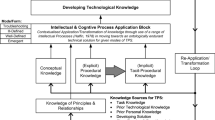Abstract
Technological problem-solving knowledge and skills have become primary components of almost any curricular endeavor in technology education for the last decades. However, our understanding of the way students approach such tasks and generate solutions is still incomplete. The main goal of this study was to trace closely Grade 7 students' work while engaged in design tasks within an unstructured learning environment. We report on a specific fragment of the process, namely on the evaluation/modification cycles which the students went through after completing the construction of the first version of a solution. The study focused on: (a) identifying the conceptual constituents of these cycles; (b) the students' decisions with reference to the original design goals in the course of these cycles; and (c) the formulation of a general reflection/decision/action model characterizing these cycles.
Similar content being viewed by others
REFERENCES
Baynes, K.: 1992, Children Designing – Learning Design, Occasional Paper No. 1, Loughborough University.
Bucciarelli, L.: 1996, Designing Engineers, MIT Press, Cambridge, MA.
De Vries, M.: 1996, ‘Technology Education: Beyond the “Technology is Applied Science” Paradigm’, Journal of Technology Education 8(1).
DES – Department of Education and Science: 1989, Design and Technology for Ages 5–16 (Final Report of the working group on Design and Technology), HMSO, London.
Fleer, M.: 1999, ‘The Science of Technology: Young Children Working Technologically’, International Journal of Technology and Design Education 9, 269–291.
Fleer, M.: 2000, ‘Working Technologically: Investigations into How Young Children Design and Make During Technology Education’, International Journal of Technology and Design Education 10, 43–59.
Gero, J. & Mc Neill, T.: 1998, ‘An Approach to the Analysis of Design Protocols’, Design Studies 19, 21–61.
Glaser, B. & Strauss, A.: 1967, The Discovery of Grounded Theory: Strategies for Qualitative Research, Aldine, New York.
Guba, E. & Lincoln Y.: 1981, Effective Evaluation, San Francisco.
Hennessey, S. & McCormick, R.: 1994, ‘The General Problem-Solving Process in Technology Education: Myth or Reality?’, in F. Banks (ed.), Teaching Technology, London, Routledge.
Hennesy, S. & Murphy, P.: 1999, ‘The Potential for Collaborative Problem Solving in Design And Technology’, International Journal of Technology and Design Education 9(1), 1–36.
Hutchinson, J. & Karsnitz, J.: 1994, Design and Problem Solving in Technology, Delmar Publishers Inc., Albany, NY.
Johnsey, R.: 1995, ‘The Design Process-Does It Exist? A Critical Review of Published Models for The Design Process in England and Wales’, International Journal of Technology and Design Education 5, 199–217.
Kipperman, D.: 1998, 'Evaluation-Modification Loops in Students' Design Process of Technological Devices, unpublished M.A. Thesis, Tel Aviv University.
McCormick, R., Murphy, P. & Henessy, S.: 1994, ‘Problem-Solving Process in Technology Education: A Pilot Study’, International Journal of Technology and Design Education 4, 5–34.
Mioduser, D.: 1998, ‘Framework for the Study of Cognitive and Curricular Issues of Technological Problem Solving’, International Journal of Technology and Design Education 8(2), 167–184.
Norman, E.: 1998, ‘The Nature of Technology for Design’, International Journal of Technology and Design Education 8, 67–87.
Owen, C.: 1998, ‘Design Research: Building the Knowledge Base’, Design Studies 19, 9–20.
Pacey, A.: 1999, Meaning in Technology, MIT Press, Cambridge, MA.
Resnick, M. & Ocko, S.: 1991, ‘Lego/Logo: Learning Through and About Design’, in I. Harel & S. Papert (eds.), Constructionism, Ablex Publishing Co., Nortwood NJ, pp. 141–150.
Rogers, G.: 1998, The Designing Stage of Design, Make and Appraise: A Case Study involving Young Children Designing, Paper presented at the Australasian Science Education Research Association conference, July 1998, Darwin, NT.
Roth, W.: 1995, ‘From “Wiggly Structures” to “Unshaky Towers”: Problem Framing, Solution Finding, and Negotiation of Course of Actions During a Civil Engineering Unit for Elementary Students’, Research in Science Education 25(4), 365–382.
Rowe, P.: 1987. Design Thinking, MIT Press, Cambridge, MA.
Science and Technology for the Junior High School: 1998, Tel Aviv University/Hebrew University/ORT Israel (Hebrew).
Tesh, R.: 1990, Qualitative Research: Analysis Types and Software Tools, Falmer, Basingstoke.
Vincenti, W.: 1990, What Engineers Know and How They Know It, John Hopkins University Press, Baltimore, MD.
Waks, L.: 2001, ‘Donald Schon's Philosophy of Design and Design Education’, International Journal of Technology and Design Education 11, 37–51.
Author information
Authors and Affiliations
Rights and permissions
About this article
Cite this article
Mioduser, D. Evaluation/Modification Cycles in Junior High Students' Technological Problem Solving. International Journal of Technology and Design Education 12, 123–138 (2002). https://doi.org/10.1023/A:1015256928387
Issue Date:
DOI: https://doi.org/10.1023/A:1015256928387




